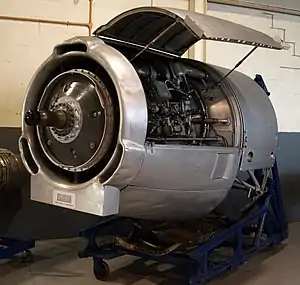Bristol Orion
The Bristol Orion aero engine was a two-shaft turboprop intended for use in later marks of the Bristol Britannia and the Canadair CL-44. Although the engine was built and underwent a development program, the BE.25 Orion project was cancelled in 1958 by the British Ministry of Supply in favour of the Rolls-Royce Tyne.[1] In addition, interest in turboprop-powered aircraft was beginning to wane, because of the successful introduction of the Boeing 707 and Douglas DC-8 jetliners into airline service.[2]
- For the 1920s piston engine of the same name, see Bristol Jupiter
| Orion | |
|---|---|
 | |
| Bristol Orion on display at the Rolls-Royce Heritage Trust, Derby | |
| Type | Turboprop |
| Manufacturer | Bristol Siddeley |
| First run | 1956 |
| Major applications | Bristol Britannia |
The Orion gas generator had been chosen by French aircraft designer Wibault to power a vectored thrust aircraft[3] which ultimately became the Hawker Siddeley P.1127 but with a Bristol Siddeley Orpheus gas generator which had a compressor derived from the Orion low pressure compressor.[1]
Design and development
A single-stage HP turbine drove a five-stage all-axial HP compressor, while a three-stage LP turbine drove both the seven-stage LP compressor and the propeller, via a reduction gearbox. Thus the Orion used a shared-load LP turbine (like the Rolls-Royce Tyne), whereas its predecessor, the Bristol Proteus, had a free-power turbine. The combustor used separate flame cans.
One novel feature of the Orion was a derate from a thermodynamic rating of 9,000 shp at sea level, to enable a constant 5,150 ehp power level to be maintained up to 15,000 ft altitude.
The Orion project was cancelled in January 1958, at a reported total cost of £4.75 million.[4]
Applications
Specifications (BOn.1 Orion)
Data from Flightglobal archive.[5]
General characteristics
- Type: Twin-spool turboprop
- Length: 112.3 in (2,850 mm)
- Diameter: 41.8 in (1,060 mm)
- Dry weight: 3,240 lb (1,470 kg)
Components
- Compressor: 7-stage LP axial flow compressor ; 5-stage HP axial flow compressor
- Combustors: Cannular combustor with 10 flame tubes
- Turbine: Single-stage HP turbine, 3-stage LP turbine
- Fuel type: Kerosene / JP-1
- Oil system: 3 independent systems at 80 psi (550 kPa)
Performance
- Maximum power output: Take-off 5,150 shp (3,840 kW) (equivalent horsepower)
- Overall pressure ratio: 10:1
- Air mass flow: 82 lb/s (37 kg/s)
- Specific fuel consumption: 0.39 lb/hp/h (0.066 kg/kW/ks) (equivalent horsepower)
- Thrust-to-weight ratio: 1.63 hp/lb (2.68 kW/kg) (equivalent horsepower)
See also
Related development
Comparable engines
Related lists
References
- Turbojet History And Development 1930-1960 - Volume 1 Great Britain and Germany, Antony L. Kay 2007, The Crowood Press Ltd., ISBN 978 1 86126 912 6, p.149
- Gunston 1989, p.35.
- Pegasus The Heart of the Harrier, Andrew Dow, Pen & Sword Aviation 2009, ISBN 978 1 84884 042 3, p.71/73
- "Cancelled projects: the list up-dated". Flight: 262. 17 August 1967.
- Flightglobal archive, 1956. Retrieved: 31 December 2008
Further reading
| Wikimedia Commons has media related to Bristol Orion. |
- "British Aero Engines 1956". Flight and Aircraft Engineer. 70 (2484): 383–393. 31 August 1956. Retrieved 16 March 2019.
- Gunston, Bill (1989). World Encyclopaedia of Aero Engines (2nd ed.). Cambridge, England: Patrick Stephens Limited. ISBN 978-1-85260-163-8.
- Hooker, Stanley, Dr. (29 April 1955). "THE SUPERCHARGED TURBOPROP Dr. Hooker's S.A.E. Lecture on the Bristol B.E. 25, Successor to the Proteus". Flight and Aircraft Engineer. 67 (2414): 545–547. Retrieved 16 March 2019.
- "ORION First Details of Bristol's New Turboprop". Flight and Aircraft Engineer. 70 (2492): 677–682. 26 October 1956. Retrieved 16 March 2019.
- Wilkinson, Paul H. (1957). Aircraft engines of the World 1957 (15th ed.). London: Sir Isaac Pitman & Sons Ltd. pp. 134–135.